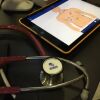AEDs have come a long way.
I chronicled the history of the AED and its impact on the Fire Service here, but the real story lies in the de-evolution of the design, from one more exclusive to use by advanced EMTs and medics, into the modern versions that can be used by almost anybody with a CPR card.
I think it is great. The first AEDs looked more like regular defibrillators, and were only carried by the well-supervised. Today, I pass by them every week in airports and hospitals. They hang on the wall like fire extinguishers or simple appliances.
Early AEDs offered a complex feature set. They had huge screens, data and voice recorders, and bulky carry handles that you almost always needed because they were so big and heavy.
Much of the design focus was on restricting access and maximizing oversight, but many of those features are rarely seen today. AEDs, by giving up features that, as it turned out, few really needed anyway, became lighter, smaller, and simpler.
Other recent improvements in AEDs have been driven by technological breakthroughs in battery technology and electronics miniaturization. Batteries are smaller and much more powerful, but so are the capacitors they have to drive and the software brains behind both.
This has enabled huge savings in both size and weight over less than 20 years. What used to carry like a loaded suitcase can now be neatly tucked under your arm. They went from 20 pounds down to under 5 — from the size of a LifePak 5 down to the size of a book — with the ruggedness of a brick.
The other big reality is that most AED’s deployed today go into airports, office buildings, and sports arenas. EMS and first responders have different needs then a layman’s device hanging on a wall.
The Philips HeartStart FRx was one of the first to explore the modern form factor made for hard use. It is still an amazingly light, reliable, and rugged AED for professionals. It is small enough to fit inside your first-in bag. It was a simple but huge step in making AEDs more conveniently and rapidly deployed.
The other big breakthrough from Philips is the HeartStart Home, the first defibrillator intended for home or personal use. It is an over-the-counter cleared device that anyone can own, which really blew the door open for many new users to access this lifesaving technology. If you have a relative at risk you can carry your own defibrillator, and now many do.
Another interesting basic AED is the Lifeline View, from Defibtech. It helps the most basic first responders remember exacly what to do by walking them through use of the device. The Lifeline View has a large, full-color interactive display that gives you step-by-step instructions for performing CPR, rescue breathing, and external defibrillation. It would be a good choice anywhere non-professional first responders are employed.
Like many of the latest generation AEDs the Lifepak 1000 has also gotten smaller, simpler, more rugged, and has also lost its carry handle. That makes it easier to fit into kits and cases, or wall-mount enclosures. It’s got a cool battery gauge, so you can see exactly what’s left in the tank. With an IP55 rating, Physio claims it is one of the most rugged defibrillators they have ever built. I personally saw a Lifepak survive ejection from a fast-moving ambulance and still work. Street professionals need a simple but very rugged product.
Another highly suitable street-ready AED is the ZOLL AED Pro. While remaining similarly proportioned to many other basic AEDs, this one retains a screen, allowing advanced clinicians access to much more information. I could see it as a perfect choice for medic-staffed engines or medic responders and special events. Its big new breakthrough feature is built-in Real CPR Help.
Real CPR Help assists better rate and depth of chest compressions during CPR. See-Thru CPR allows a rescuer to view a patient’s underlying ECG rhythm while performing CPR. By using real-time feedback you can vastly improve rate and depth of compressions. I think it is really very cool.
Real CPR Help also has an IP55 Rating. It can withstand a 1.5-meter drop test, which should make it highly suitable for withstanding the rough treatment typically found in an emergency medical environment. It has ECG monitoring, with a 3-lead cable and a high-quality display, so a medic’s first response or special events needs can now can now be supported in a tiny package.
When deciding which AED to buy, first ask yourself how it will be used and by whom. If it’s by someone like a cop or a fireman who will bang it around every day, then you need to stick with the manufacturers that know how bad that abuse can be. Maybe the health club can shop around, but the guys throwing these things around need a robust product.
My best advice is not to be penny wise and pound foolish. I detailed some additional tips about making this decision in my article, ‘How to Buy AED’s’.













